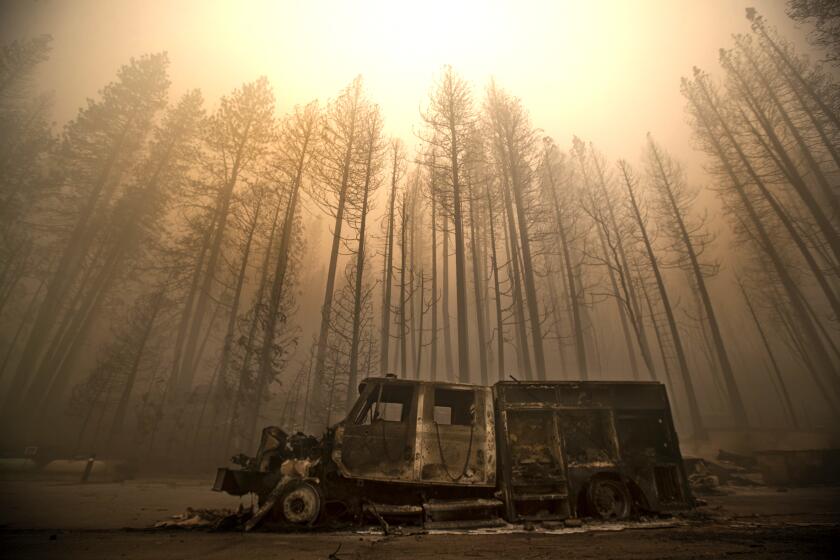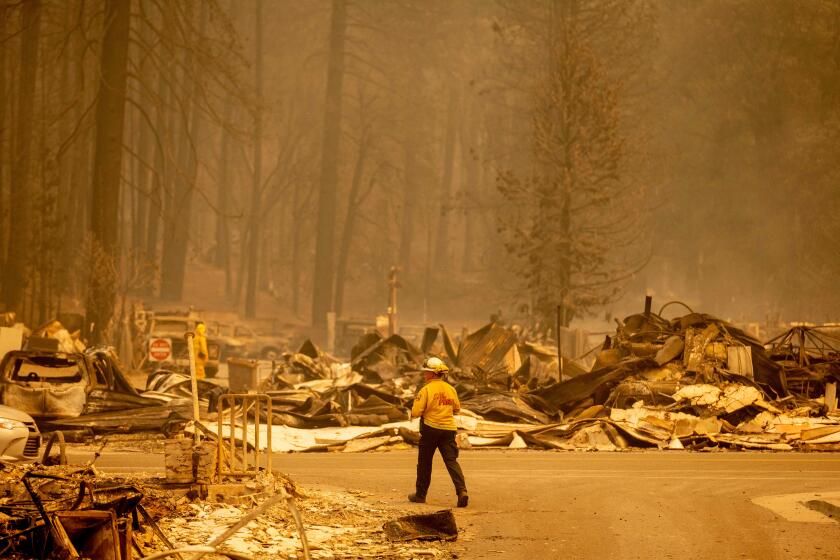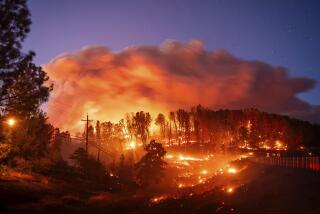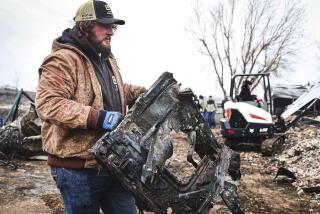Dixie wildfire explodes to 430,000 acres, third largest in California history
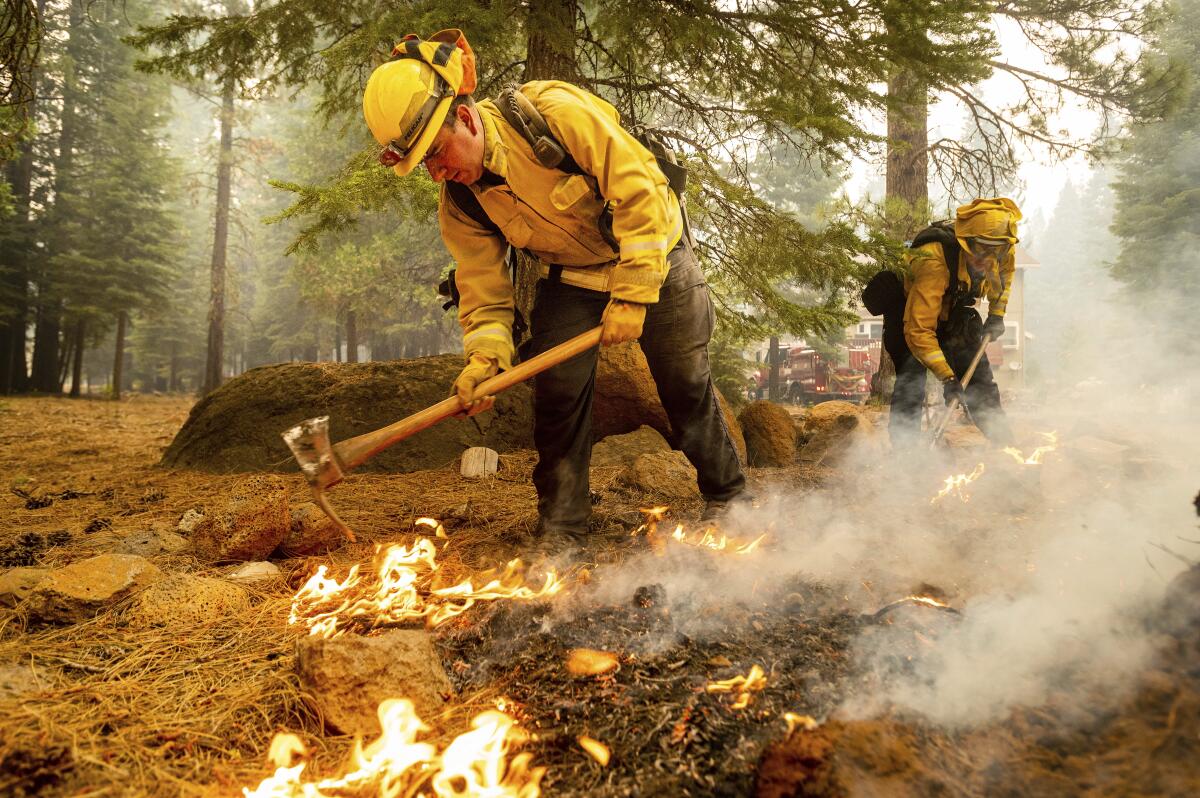
- Share via
GREENVILLE, Calif. — Driven by fierce winds and bone-dry conditions, the Dixie fire exploded to 432,813 acres in Northern California, having grown more than 100,000 acres in the last 24 hours. The blaze is now the third-largest wildfire in California history and the largest to burn in the U.S. this year, surpassing the massive Bootleg fire in Oregon.
The fire, which started on July 13 in Feather River Canyon north of Sacramento, has destroyed at least 134 structures, threatens 13,871 more, and has sent thousands of area residents fleeing from their homes, officials said. The huge blaze that leveled a Gold Rush town is now burning in four counties — Butte, Lassen, Plumas and Tehama — and remains 35% contained.
Officials say a perfect storm of conditions has driven the fire’s rapid spread. The blaze was sixth on California’s list of largest wildfires just Thursday.
Early in the week, the Dixie fire continued to grow and the River fire burned homes north of Sacramento.
“It’s all of the things together,” said Capt. Mitch Matlow, spokesperson for the Dixie fire. “It’s the heat. It’s the dry fuels. It’s the drought. It’s the wind we saw yesterday. It’s the slope.”
With vegetation so dry, an ember colliding with it at times “was almost guaranteed to ignite and start another spot fire,” said Rick Carhart, another spokesperson for the fire.
Fire growth was predicted to slow down Friday amid more stable weather conditions, according to the fire behavior analyst and incident meteorologist.
Smoke from several regional fires was expected to amass over the Dixie fire on Friday, lowering temperatures and driving up humidity — which is good for firefighting efforts — but also souring air quality, said Ryan Walbrun, incident meteorologist for the Dixie fire.
“The smoke is, of course, not fun to breathe in and whatnot, but it should help out with the fire environment,” Walbrun said during a briefing Thursday evening.
Powerful winds surged Thursday and through the night, sending flames hurtling north and pushing ash and smoke swirling into blackened skies. Gusts were so strong near the Lake Almanor Peninsula area — where the fire hasn’t reached — that they uprooted a pine tree and hurled it into an outbuilding, said Mike Wink, an operations section chief for the fire, during a Friday morning update.
By Thursday evening, the flames surged past the town of Chester and into the Lassen Volcanic National Park, forcing the park’s closure.
Firefighters were defending homes all around Lake Almanor, where the fire had reached the western shore.
Wink said that two homes and a garage were destroyed or damaged in West Almanor, but crews successfully protected several hundred other structures in the community.
As Susanville Mayor Mendy Schuster drove to a meeting at City Hall just before 5 p.m. Thursday, the sky was so black that streetlights came on.
“It was dark. I had my headlights on. Ash was falling,” she said.
When she got inside the building, there was ash all over her pink jacket.
The Northern Sierra Air Quality Management District and public health departments in Nevada, Plumas and Sierra counties on Thursday extended a joint health advisory for air quality “due to the prolonged and widespread smoke” from the Dixie and River fires.
Poor air quality, “possibly reaching hazardous levels,” is expected to last as long as the fires are active, the advisory says. Health officials have advised people in the area to stay inside and keep their windows closed, minimize outdoor activity and stay hydrated.
Lassen County’s skies turned an eerie orange for hours on Thursday afternoon.
The growing fire has spurred dozens of evacuation orders across a quartet of counties, affecting roughly 31,000 people, according to Chris Carlton, supervisor for the Plumas National Forest.
As of Thursday, much of western Lassen County was under evacuation, county Sheriff Dean Growdon said.
Lassen Community College President Trevor Albertson said hundreds of Dixie fire evacuees are staying on his Susanville campus. The shelter was initially set up for nearby Plumas County residents displaced by the blaze, Growdon said.
“I’ve got people in the gym, in RVs, classrooms. People are camping out on my grass,” Albertson said. The school is feeding evacuees. Nursing students and staff are treating them.
“There’s a lot of fear, but at the same time, there’s a lot of stick-to-itiveness, for lack of a better term,” he added.
Authorities set up an additional evacuation center at Lassen High School.
Some of the worst fire damage was in Greenville, a small town that was overrun by the blaze on Wednesday.
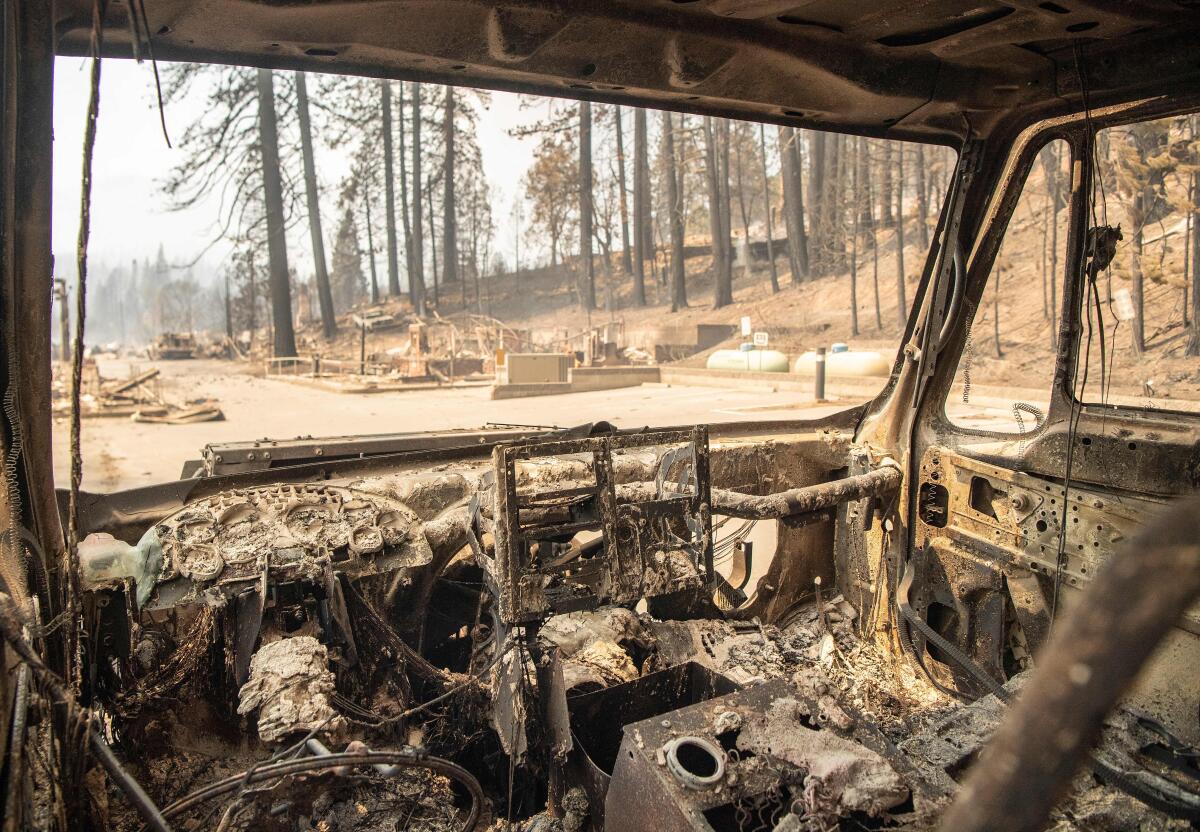
Plumas County Sheriff Todd Johns struck a somber tone at a briefing Thursday night, describing himself as a lifelong resident of Greenville.
“My heart is crushed by what has occurred there, and to the folks that have lost residences and businesses — I’ve met some of them already — their life is now forever changed,” he said.
“And all I can tell you is, I’m sorry.”
Greenville, a Gold Rush town dating to the 19th century, rebuilt after an 1881 fire. Now it has been destroyed by the Dixie fire, California’s largest this year.
More than 5,000 personnel are attacking the blaze. Johns said they were making a valiant effort and are “being met with complete and utter devastation at every turn.”
Greenville was a smoking ruin by Thursday morning, its sign melted so that the lettering crackled like glaze. Entire blocks were razed. Flames still flickered where they could find perches on something left to burn. Hulls of cars lined the street, reduced to charred tanks and melted wheels.
The U.S. Postal Service building was standing, but inside, the banks of P.O. boxes lay collapsed on the ground, their doors burned off. The gas station was smoldering, its metal roof twisted and swollen, its pumps burned-out shells.
At Main and Crescent streets, the historic Bransford & McIntyre Store was reduced to its walls and five steel doors that were meant to protect it from just such a fate. A plaque on the front of the building said the store had been built on this site in the mid-1870s but burned in an 1881 fire. It was immediately replaced with a brick building that, according to a plaque, was “built like a fortress,” complete with “steel shuttered doors and windows.”
None of it was enough to save the store from the Dixie fire.
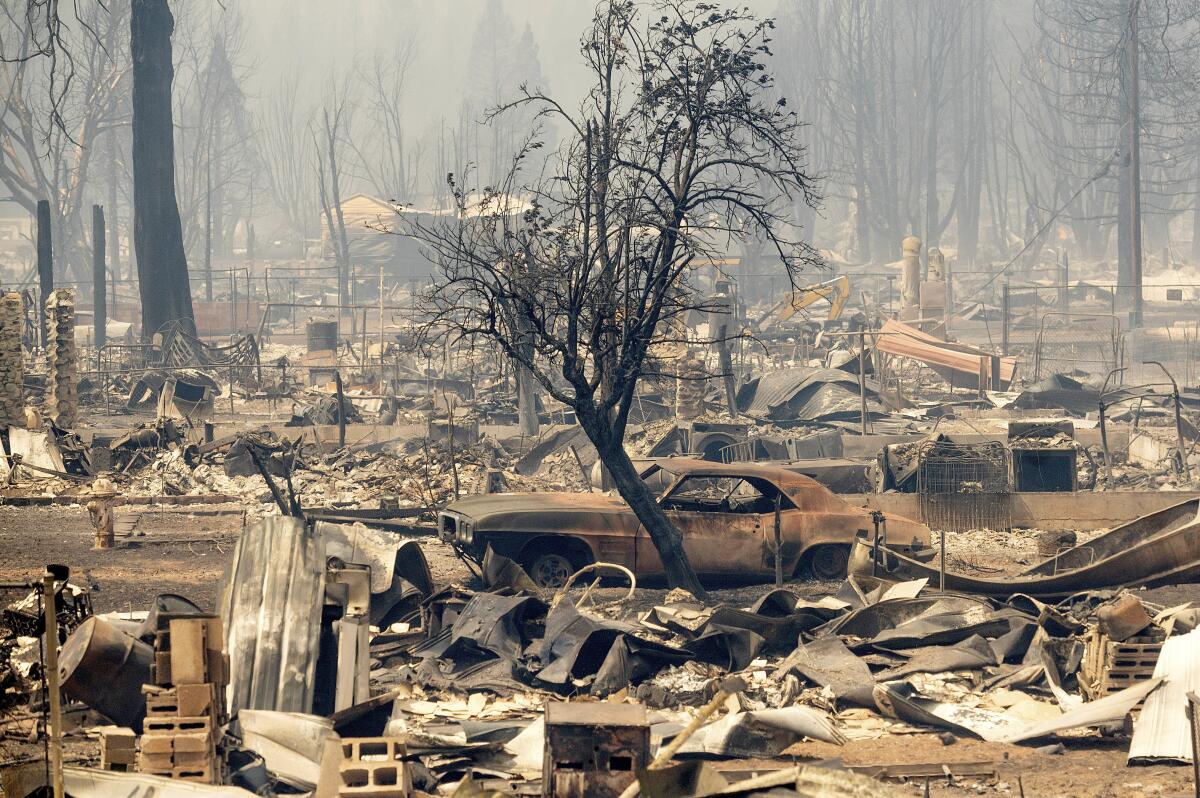
“The whole historic downtown area is gone,” said Kevin Goss, a Plumas County supervisor who owned a pharmacy in the town — its oldest building, dating back to 1860, he said.
Goss had gone into town Wednesday and saw the fire jump off the hillside, raining sparks and embers around Greenville. It swept through “like a blowtorch,” he said
On Friday, Goss was finally able to return to the town since evacuating the night of the fire. The road so filled with smoke that it required headlights in the middle of the day, as he edged toward what he really wanted to see: the pharmacy.
When it finally came into sight, there was little but shock on his face.
Nothing remained.
Standing above the ruin, Goss gave a short and mirthless laugh.
“I didn’t even know there were bricks inside some of these walls,” he said, looking at their remains in the rubble. “That’s funny.”
“You think you are prepared for it, but I guarantee you, you are not,” he told an NBC news crew.
Fire officials said they battled the blaze in Greenville for hours, and many people — although not all — fled as the flames approached.
But there was much that could not be saved.
Curtis Machlan alternated between past and present tense as he spoke about Greenville.
The 58-year-old in 2007 moved to the Gold Rush-era town, where the population sign read more than 2,000 people but where the community numbers just over 1,000.
It’s the town where he met his wife, Kimberly, who had moved to the area in the late 1990s from San Jose.
“We’d go to the local grocery store and sometimes it would take over an hour to get out, just to run in and get a gallon of milk or something, because we knew everybody,” Machlan said.
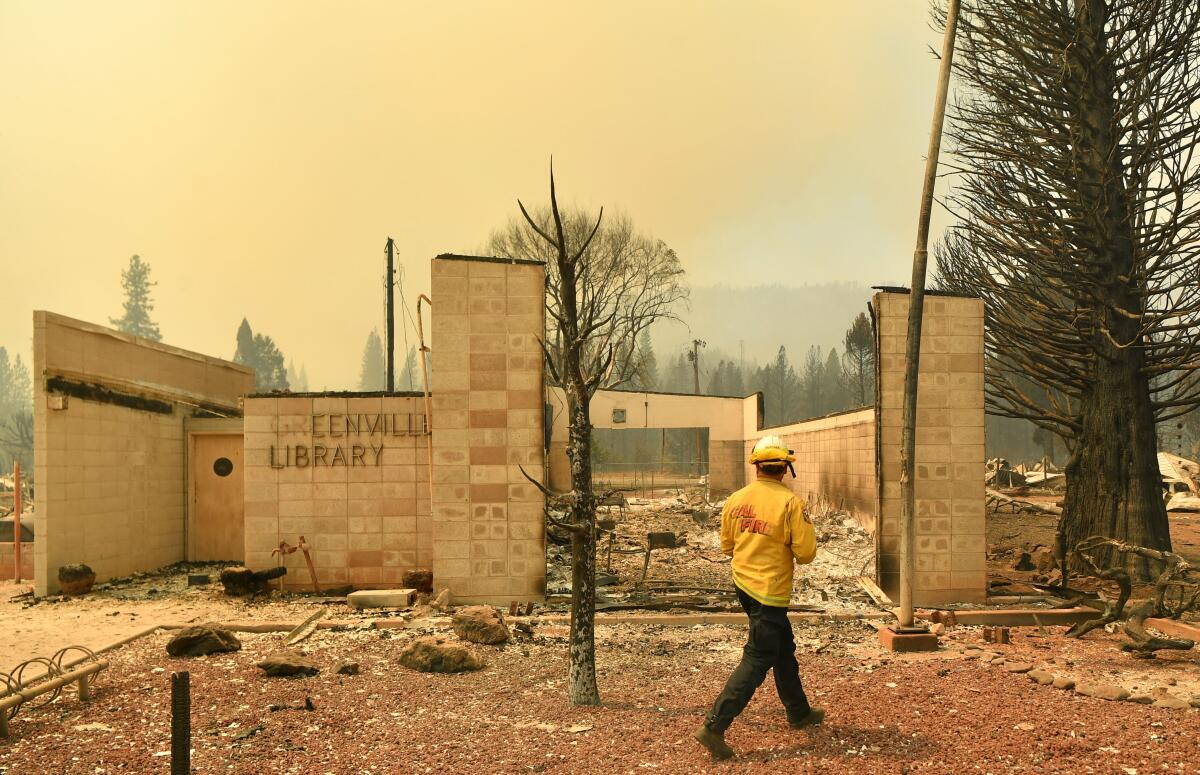
The library where Machlan’s wife once worked burned down. The building that housed the auto parts store where Machlan once worked was gone, too.
On Thursday, he heard from a friend who stayed and tried to fight the fire in a pasture behind the Machlan home. He said the house had been reduced to ash. Neighbors’ homes were also destroyed.
The friend described the scene as a “moonscape.”
“It’s tragic for so many people,” Machlan said, adding that the catastrophe came as no surprise because conditions in the Sierra Nevada have been the driest he’s ever seen.
“Even just with that sense that I knew it was coming, it’s like losing a loved one,” he said. “Like a death of a loved one.”
“It’s the climate change,” Machlan said. “Everybody who didn’t believe it in Greenville is now a climate refugee.”
Although the town of Greenville was decimated and the fire also moved through the community of Canyon Dam on Thursday, firefighters worked in and around Chester, and there were no reports of homes burned there as of Friday morning, said Carhart, the fire spokesperson.
The town’s logging mill was also saved, he said.
“The fire easily could have just gone in there and consumed that whole town,” he said. “Anytime they [firefighters] have success, it gives them the energy they need to go back in there and do it again the next day.”
Pacific Gas & Electric Co. has said that its equipment may have sparked the fire July 13 but that a worker didn’t get to the site and discover the flames until 9½ hours later.
On Monday, the utility company disclosed that its equipment may also have ignited the Fly fire, which started July 22 off Highway 70 and grew to 4,300 acres before it merged with the Dixie fire two days later.
The utility said it was taking additional safety measures, including attempting to respond to any fault or outage in a high-fire-risk area within 60 minutes or less, in light of this season’s severe burning conditions.
More to Read
Sign up for Essential California
The most important California stories and recommendations in your inbox every morning.
You may occasionally receive promotional content from the Los Angeles Times.
